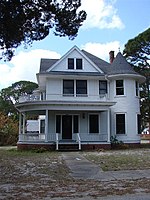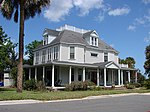NASA Causeway
Bascule bridges in the United StatesBridges in Brevard County, FloridaBridges over the Indian River (Florida)Causeways in FloridaIndian River Lagoon ... and 3 more
Kennedy Space CenterRoad bridges in FloridaRoads in Brevard County, Florida

NASA Parkway, also known as NASA Causeway, is an east–west expressway in Brevard County, Florida, containing two causeways. The first causeway connects the Florida mainland to Merritt Island and later, over the private second causeway, connects Merritt Island to Cape Canaveral. As such, the NASA Parkway is the main route connecting points of interest in Titusville, Florida to the Kennedy Space Center on Merritt Island.
Excerpt from the Wikipedia article NASA Causeway (License: CC BY-SA 3.0, Authors, Images).NASA Causeway
NASA Causeway,
Geographical coordinates (GPS) Address Nearby Places Show on map
Geographical coordinates (GPS)
| Latitude | Longitude |
|---|---|
| N 28.5275764 ° | E -80.7709017 ° |
Address
NASA Causeway
NASA Causeway
Florida, United States
Open on Google Maps






